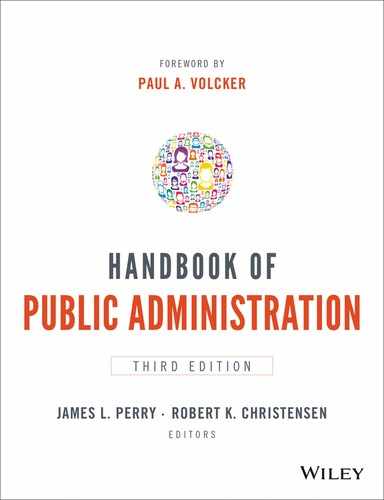Part 2
Building Infrastructures for Accountability
Part 2 focuses on the dual concerns of democratic control and administrative effectiveness. Accountability and responsiveness are influenced by administrative arrangements just as they are by the quality of the people who serve. The chapter authors show how laws and institutions shape administrative behavior and thereby promote major governance goals. They ably emphasize several key facets of accountability: responsibility, transparency, and responsiveness.
Laws, governmental institutions, and work organizations are vital parts of the context for administrative action. In one sense, public administrators are creatures of their environments: they function within legal, political, and organizational systems intended to shape their behaviors and decisions. At the same time, the effectiveness of the systems within which public administrators work often depends on their choices and actions.
In chapter 5, Phillip Cooper illustrates both sides of this duality. The US Constitution embodies relatively permanent principles that are at the heart of the American system of laws. Cooper argues that the rule of law has never been more important to administrative legitimacy. The rule of law constrains administrative action in ways that promote responsibility and accountability. Constitutional and other legal boundaries protect citizens from what Cooper refers to as maladministration. He argues as well that law promotes responsibility through empowerment as well. So while an administrator's adherence to law can be constraining, it can also promote and empower the exercise of administrative discretion in managing accountabilities and expectations. In this sense law serves as an important “mechanism of change,” and Cooper urges us to consider this empowerment in multiple ways. For example, an administrator's respect for law gives courts and political authorities the latitude to allocate discretion and deference to unelected officials and for their decisions to have the force of law. As Cooper persuasively argues, legal devices can be valuable tools that promote orderly decisions, reduce arbitrariness, and improve morale. Thus, our system of laws facilitates both accountability and responsiveness.
Milena Neshkova and Allan Rosenbaum contextualize these issues of accountability and responsiveness in chapter 6 through a careful international examination of public corruption. They make a compelling case that corruption—more ubiquitous than some may think—comes with high costs, not least of which is the diminution of the legitimacy of government. Creating institutions, cultures, and processes of accountability is key to reducing the prevalence of corruption. Because individual administrators can contribute to key cultural changes within their respective organizations, Neshkova and Rosenbaum offer valuable insight into lasting change. The accountability needed to combat corruption must be fostered internally if external and institutional factors are to be effective.
This more holistic view of accountability is developed in chapter 7 by Gregory Porumbescu and Tobin Im. They convincingly argue for transparency's central role as a key tool to promote an infrastructure of administrative accountability, while also offering much-needed contour to the transparency-accountability-responsiveness relationship. Developments in information technology put public administrators in the position to usher in unprecedented levels of transparency, but the authors caution that external checks may be required to ensure that the additional transparency accommodates equality. There is a legitimate question as to which parts of the citizenry are best positioned to encourage and benefit from transparency-induced government responsiveness. Tina Nabatchi, Jack Becker, and Matt Leighninger engage these and broader themes of citizen participation in chapter 8. Along with other authors in part 2, they look at factors contributing to an infrastructure of administrative accountability. They focus on citizen participation and suggest that certain modes of citizen participation are better matched than others to achieve different aspects of administrative accountability. Public administrators are therefore encouraged to be thoughtful about features used to design accountability infrastructure.
For generations, accountability has been understood in terms of the contrast between systemic constraints, that is, external controls, and independent action, that is, self-control. Part 2 explores how public administrators do and should exercise their discretion when balancing contrasting demands for accountability and responsiveness and offers thoughtful insights into how accountability systems might be designed and improved. It thus assesses the accountability expectations confronting public administrators, the extent to which administrators are creatures of their environments, but also how they can respond to them to improve accountability.
